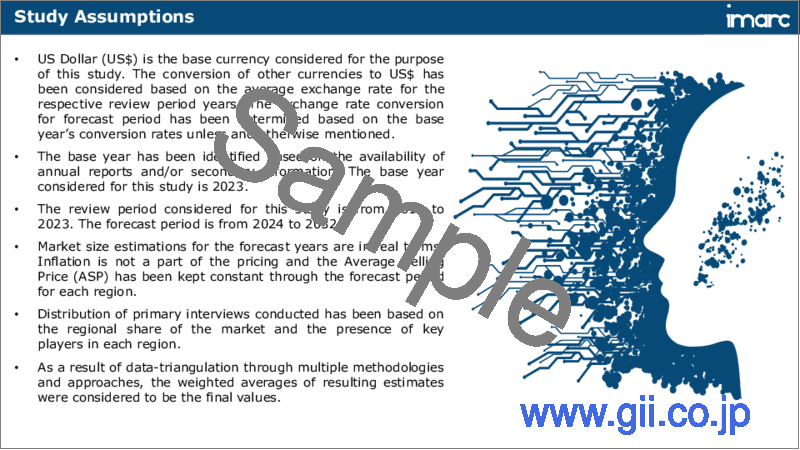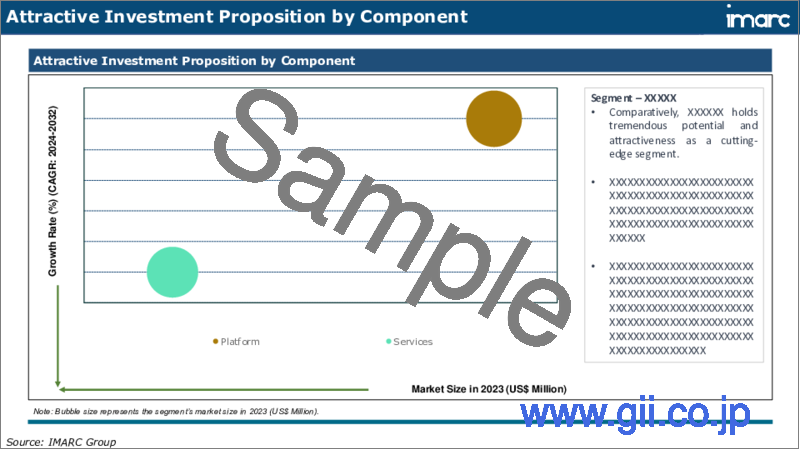|
|
市場調査レポート
商品コード
1609667
日本の対話AI市場レポート:コンポーネント、タイプ、技術、展開、組織規模、エンドユーザー、地域別、2025年~2033年Japan Conversational AI Market Report by Component, Type (Intelligent Virtual Assistant, Chatbots), Technology, Deployment, Organization Size, End User, and Region 2025-2033 |
||||||
カスタマイズ可能
|
|||||||
| 日本の対話AI市場レポート:コンポーネント、タイプ、技術、展開、組織規模、エンドユーザー、地域別、2025年~2033年 |
|
出版日: 2024年12月05日
発行: IMARC
ページ情報: 英文 116 Pages
納期: 5~7営業日
|
全表示
- 概要
- 目次
日本の対話AI市場の市場規模は2024年に7億2,700万米ドルに達しました。今後、IMARC Groupは、市場は2033年までに30億9,200万米ドルに達し、2025年から2033年にかけて17.5%の成長率(CAGR)を示すと予測しています。効率的でパーソナライズされたサポートを提供し、全体的な顧客体験を向上させるために、企業によるバーチャルアシスタントとチャットボットの採用が増加していることが、主に市場の成長を促進しています。
本レポートで回答した主な質問
- 日本の対話AI市場はこれまでどのように推移し、今後どのように推移するのか?
- COVID-19が日本の対話AI市場に与えた影響は?
- 日本の対話AI市場のコンポーネント別の内訳は?
- 日本の対話AI市場のタイプ別構成比は?
- 日本の対話AI市場の技術別の内訳は?
- 日本の対話AI市場の展開別の内訳は?
- 日本の対話AI市場の組織規模別の内訳は?
- 日本の対話AI市場のエンドユーザー別の内訳は?
- 日本の対話AI市場のバリューチェーンにはどのような段階がありますか?
- 日本の対話AIの主な促進要因と課題は何か?
- 日本の対話AI市場の構造と主要プレーヤーは?
- 日本の対話AI市場における競合の程度は?
目次
第1章 序文
第2章 調査範囲と調査手法
- 調査の目的
- ステークホルダー
- データソース
- 市場推定
- 調査手法
第3章 エグゼクティブサマリー
第4章 日本の対話AI市場:イントロダクション
- 概要
- 市場力学
- 業界動向
- 競合情報
第5章 日本の対話AI市場情勢
- 過去および現在の市場動向(2019年~2024年)
- 市場予測(2025-2033)
第6章 日本の対話AI市場:コンポーネント別の内訳
- プラットフォーム
- サービス
第7章 日本の対話AI市場:タイプ別の内訳
- インテリジェントバーチャルアシスタント(IVA)
- チャットボット
第8章 日本の対話AI市場:技術別の内訳
- 機械学習
- ディープラーニング
- 自然言語処理
- 自動音声認識
第9章 日本の対話AI市場:展開別の内訳
- クラウドベース
- オンプレミス
第10章 日本の対話AI市場:組織規模別の内訳
- 大企業
- 中小企業
第11章 日本の対話AI市場:エンドユーザー別の内訳
- BFSI
- 小売業とeコマース
- ヘルスケアとライフサイエンス
- 旅行とホスピタリティ
- 通信
- メディアとエンターテイメント
- その他
第12章 日本の対話AI市場:競合情勢
- 概要
- 市場構造
- 市場プレーヤーのポジショニング
- 主要成功戦略
- 競合ダッシュボード
- 企業評価象限
第13章 主要企業のプロファイル
第14章 日本の対話AI市場:業界分析
- 促進要因・抑制要因・機会
- ポーターのファイブフォース分析
- バリューチェーン分析
第15章 付録
Japan conversational AI market size reached USD 727 Million in 2024. Looking forward, IMARC Group expects the market to reach USD 3,092 Million by 2033, exhibiting a growth rate (CAGR) of 17.5% during 2025-2033. The increasing adoption of virtual assistants and chatbots by companies to provide efficient and personalized support and improve overall customer experiences is primarily driving the market growth.
Conversational AI is a transformative technology that enables machines, typically computer programs or chatbots, to engage in human-like conversations with users. It leverages natural language processing (NLP) and machine learning algorithms to understand and generate human language, allowing for more intuitive and human-friendly interactions between humans and machines. Conversational AI finds applications across various domains, including customer service, virtual assistants, healthcare, and education. It enables automated responses to user queries, facilitates information retrieval, and can even execute tasks based on user instructions. By continuously improving its understanding of context and user preferences, conversational AI systems strive to provide increasingly personalized and efficient interactions, making it a powerful tool for enhancing user experiences and streamlining processes in both commercial and everyday contexts.
Japan Conversational AI Market Trends:
The Japan conversational AI market is a rapidly evolving and promising sector within the country's technology landscape. Renowned for its innovation and technological prowess, Japan has been actively adopting and advancing conversational AI solutions across various industries. One key driver of this growth is the country's strong focus on improving customer service and user experiences. Japanese companies, from e-commerce to customer support centers, are increasingly integrating conversational AI chatbots and virtual assistants to streamline interactions and enhance efficiency. Furthermore, as Japan faces an aging population, conversational AI is also being explored as a solution to address healthcare and elderly care needs. The market's expansion is further fueled by collaborative efforts between industry players, research institutions, and government initiatives that promote AI development. As conversational AI technology continues to mature, the Japan market is well-positioned to play a pivotal role in shaping the future of human-machine interactions, offering innovative solutions for businesses and addressing societal challenges.
Japan Conversational AI Market Segmentation:
Component Insights:
- Platform
- Services
- Support and Maintenance
- Training and Consulting
- System Integration
Type Insights:
- Intelligent Virtual Assistant (IVA)
- Chatbots
Technology Insights:
- Machine Learning
- Deep Learning
- Natural Language Processing
- Automatic Speech Recognition
Deployment Insights:
- Cloud-based
- On-premises
Organization Size Insights:
- Large Enterprises
- Small and Medium-sized Enterprises
End User Insights:
- BFSI
- Retail and E-commerce
- Healthcare and Life Science
- Travel and Hospitality
- Telecom
- Media and Entertainment
- Others
Competitive Landscape:
The market research report has also provided a comprehensive analysis of the competitive landscape in the market. Competitive analysis such as market structure, key player positioning, top winning strategies, competitive dashboard, and company evaluation quadrant has been covered in the report. Also, detailed profiles of all major companies have been provided.
Key Questions Answered in This Report:
- How has the Japan conversational AI market performed so far and how will it perform in the coming years?
- What has been the impact of COVID-19 on the Japan conversational AI market?
- What is the breakup of the Japan conversational AI market on the basis of component?
- What is the breakup of the Japan conversational AI market on the basis of type?
- What is the breakup of the Japan conversational AI market on the basis of technology?
- What is the breakup of the Japan conversational AI market on the basis of deployment?
- What is the breakup of the Japan conversational AI market on the basis of organization size?
- What is the breakup of the Japan conversational AI market on the basis of end user?
- What are the various stages in the value chain of the Japan conversational AI market?
- What are the key driving factors and challenges in the Japan conversational AI?
- What is the structure of the Japan conversational AI market and who are the key players?
- What is the degree of competition in the Japan conversational AI market?
Table of Contents
1 Preface
2 Scope and Methodology
- 2.1 Objectives of the Study
- 2.2 Stakeholders
- 2.3 Data Sources
- 2.3.1 Primary Sources
- 2.3.2 Secondary Sources
- 2.4 Market Estimation
- 2.4.1 Bottom-Up Approach
- 2.4.2 Top-Down Approach
- 2.5 Forecasting Methodology
3 Executive Summary
4 Japan Conversational AI Market - Introduction
- 4.1 Overview
- 4.2 Market Dynamics
- 4.3 Industry Trends
- 4.4 Competitive Intelligence
5 Japan Conversational AI Market Landscape
- 5.1 Historical and Current Market Trends (2019-2024)
- 5.2 Market Forecast (2025-2033)
6 Japan Conversational AI Market - Breakup by Component
- 6.1 Platform
- 6.1.1 Overview
- 6.1.2 Historical and Current Market Trends (2019-2024)
- 6.1.3 Market Forecast (2025-2033)
- 6.2 Services
- 6.2.1 Overview
- 6.2.2 Historical and Current Market Trends (2019-2024)
- 6.2.3 Market Segmentation
- 6.2.3.1 Support and Maintenance
- 6.2.3.2 Training and Consulting
- 6.2.3.3 System Integration
- 6.2.4 Market Forecast (2025-2033)
7 Japan Conversational AI Market - Breakup by Type
- 7.1 Intelligent Virtual Assistant (IVA)
- 7.1.1 Overview
- 7.1.2 Historical and Current Market Trends (2019-2024)
- 7.1.3 Market Forecast (2025-2033)
- 7.2 Chatbots
- 7.2.1 Overview
- 7.2.2 Historical and Current Market Trends (2019-2024)
- 7.2.3 Market Forecast (2025-2033)
8 Japan Conversational AI Market - Breakup by Technology
- 8.1 Machine Learning
- 8.1.1 Overview
- 8.1.2 Historical and Current Market Trends (2019-2024)
- 8.1.3 Market Forecast (2025-2033)
- 8.2 Deep Learning
- 8.2.1 Overview
- 8.2.2 Historical and Current Market Trends (2019-2024)
- 8.2.3 Market Forecast (2025-2033)
- 8.3 Natural Language Processing
- 8.3.1 Overview
- 8.3.2 Historical and Current Market Trends (2019-2024)
- 8.3.3 Market Forecast (2025-2033)
- 8.4 Automatic Speech Recognition
- 8.4.1 Overview
- 8.4.2 Historical and Current Market Trends (2019-2024)
- 8.4.3 Market Forecast (2025-2033)
9 Japan Conversational AI Market - Breakup by Deployment
- 9.1 Cloud-based
- 9.1.1 Overview
- 9.1.2 Historical and Current Market Trends (2019-2024)
- 9.1.3 Market Forecast (2025-2033)
- 9.2 On-premises
- 9.2.1 Overview
- 9.2.2 Historical and Current Market Trends (2019-2024)
- 9.2.3 Market Forecast (2025-2033)
10 Japan Conversational AI Market - Breakup by Organization Size
- 10.1 Large Enterprises
- 10.1.1 Overview
- 10.1.2 Historical and Current Market Trends (2019-2024)
- 10.1.3 Market Forecast (2025-2033)
- 10.2 Small and Medium-sized Enterprises
- 10.2.1 Overview
- 10.2.2 Historical and Current Market Trends (2019-2024)
- 10.2.3 Market Forecast (2025-2033)
11 Japan Conversational AI Market - Breakup by End User
- 11.1 BFSI
- 11.1.1 Overview
- 11.1.2 Historical and Current Market Trends (2019-2024)
- 11.1.3 Market Forecast (2025-2033)
- 11.2 Retail and E-commerce
- 11.2.1 Overview
- 11.2.2 Historical and Current Market Trends (2019-2024)
- 11.2.3 Market Forecast (2025-2033)
- 11.3 Healthcare and Life Science
- 11.3.1 Overview
- 11.3.2 Historical and Current Market Trends (2019-2024)
- 11.3.3 Market Forecast (2025-2033)
- 11.4 Travel and Hospitality
- 11.4.1 Overview
- 11.4.2 Historical and Current Market Trends (2019-2024)
- 11.4.3 Market Forecast (2025-2033)
- 11.5 Telecom
- 11.5.1 Overview
- 11.5.2 Historical and Current Market Trends (2019-2024)
- 11.5.3 Market Forecast (2025-2033)
- 11.6 Media and Entertainment
- 11.6.1 Overview
- 11.6.2 Historical and Current Market Trends (2019-2024)
- 11.6.3 Market Forecast (2025-2033)
- 11.7 Others
- 11.7.1 Historical and Current Market Trends (2019-2024)
- 11.7.2 Market Forecast (2025-2033)
12 Japan Conversational AI Market - Competitive Landscape
- 12.1 Overview
- 12.2 Market Structure
- 12.3 Market Player Positioning
- 12.4 Top Winning Strategies
- 12.5 Competitive Dashboard
- 12.6 Company Evaluation Quadrant
13 Profiles of Key Players
- 13.1 Company A
- 13.1.1 Business Overview
- 13.1.2 Product Portfolio
- 13.1.3 Business Strategies
- 13.1.4 SWOT Analysis
- 13.1.5 Major News and Events
- 13.2 Company B
- 13.2.1 Business Overview
- 13.2.2 Product Portfolio
- 13.2.3 Business Strategies
- 13.2.4 SWOT Analysis
- 13.2.5 Major News and Events
- 13.3 Company C
- 13.3.1 Business Overview
- 13.3.2 Product Portfolio
- 13.3.3 Business Strategies
- 13.3.4 SWOT Analysis
- 13.3.5 Major News and Events
- 13.4 Company D
- 13.4.1 Business Overview
- 13.4.2 Product Portfolio
- 13.4.3 Business Strategies
- 13.4.4 SWOT Analysis
- 13.4.5 Major News and Events
- 13.5 Company E
- 13.5.1 Business Overview
- 13.5.2 Product Portfolio
- 13.5.3 Business Strategies
- 13.5.4 SWOT Analysis
- 13.5.5 Major News and Events
14 Japan Conversational AI Market - Industry Analysis
- 14.1 Drivers, Restraints, and Opportunities
- 14.1.1 Overview
- 14.1.2 Drivers
- 14.1.3 Restraints
- 14.1.4 Opportunities
- 14.2 Porters Five Forces Analysis
- 14.2.1 Overview
- 14.2.2 Bargaining Power of Buyers
- 14.2.3 Bargaining Power of Suppliers
- 14.2.4 Degree of Competition
- 14.2.5 Threat of New Entrants
- 14.2.6 Threat of Substitutes
- 14.3 Value Chain Analysis






